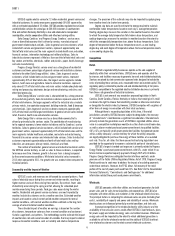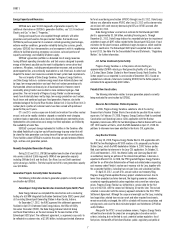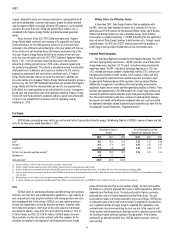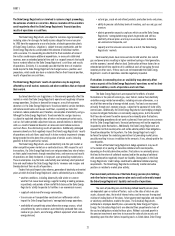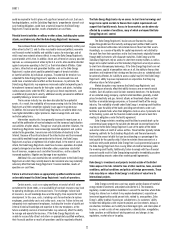Duke Energy 2012 Annual Report Download - page 34
Download and view the complete annual report
Please find page 34 of the 2012 Duke Energy annual report below. You can navigate through the pages in the report by either clicking on the pages listed below, or by using the keyword search tool below to find specific information within the annual report.
PART I
14
Hydroelectric Generating Facilities.
All but one of USFE&G’s hydroelectric generating facilities are licensed
by the FERC under Part I of the Federal Power Act. The FERC has jurisdiction to
issue new hydroelectric operating licenses when the existing license expires. The
13 hydroelectric stations of the Catawba-Wateree Project are in the late stages
of the FERC relicensing process. These stations continue to operate under
annual extensions of the current FERC license, which expired in 2008, until the
FERC issues a new license, which is currently projected to be issued by mid-
2013. Relicensing is now under way for two hydroelectric stations comprising
the Keowee-Toxaway Project. The current Keowee-Toxaway Project license does
not expire until 2016 and the project will continue to operate under the current
license until the new license is issued. The Bad Creek Project license will expire
in 2028, the Gaston Shoals Project and Ninety Nine Islands Project licenses will
expire in 2036 and the Queens Creek Project which will expire in 2023. All other
hydroelectric stations are operating under current operating licenses, including
ten hydroelectric stations in the East Fork, West Fork, Nantahala, Bryson,
Mission, Franklin projects, and the Markland Project (in Indiana) for which
new licenses were issued in 2010 through 2012. Duke Energy requested and
the FERC approved a license surrender for the Dillsboro project. Duke Energy
Carolinas has removed the Dillsboro Project dam and powerhouse as part of
multi-project and multi-stakeholder agreements and Duke Energy Carolinas is
continuing with stream restoration and post-removal monitoring as requested by
FERC’s license surrender order.
Progress Energy Carolinas has three hydroelectric generating plants
licensed by the FERC: Walters, Tillery and Blewett. Progress Energy Carolinas
also owns the Marshall Plant, which has a license exemption. The total summer
generating capacity for all four units is 225 MW. Progress Energy Carolinas
submitted an application to relicense its Tillery and Blewett plants for 50 years
and anticipates a decision by the FERC in 2013. The Walters Plant license will
expire in 2034.
Other Matters.
USFE&G is subject to the jurisdiction of the U.S. Environmental Protection
Agency (EPA) and state and local environmental agencies. For a discussion of
environmental regulation, see “Environmental Matters” in this section.
See “Other Issues” section of Management’s Discussion and Analysis of
Financial Condition and Results of Operations for a discussion about potential
Global Climate Change legislation and other EPA regulations under development
and the potential impacts such legislation and regulation could have on Duke
Energy’s operations.
COMMERCIAL POWER
Commercial Power owns, operates and manages power plants and
engages in the wholesale marketing and procurement of electric power, fuel
and emission allowances related to these plants as well as other contractual
positions. Commercial Power’s generation operations, excluding renewable
energy generation assets, consist primarily of coal-fi red and gas-fi red
nonregulated generation assets which are dispatched into wholesale markets.
These assets are comprised of 6,825 net MW of power generation primarily
located in the Midwestern U.S. The asset portfolio has a diversifi ed fuel mix with
baseload and mid-merit coal-fi red units as well as combined cycle and peaking
natural gas-fi red units. The coal-fi red generation assets were dedicated under
the Duke Energy Ohio Electric Security Plan (ESP) through December 31, 2011.
As discussed in the USFE&G section above, the new ESP effectively separates
the generation of electricity from Duke Energy Ohio’s retail load obligation as of
January 1, 2012. As a result, As a result, the energy from Duke Energy Ohio’s
coal-fi red generation assets no longer serve retail load customers or receive
negotiated pricing under the ESP. Effective January 1, 2012, Duke Energy Ohio
completed its Regional Transmission Organization (RTO) realignment to PJM and
operates as a Fixed Resource Requirement (FRR) entity through May 31, 2015.
As an FRR entity, Duke Energy Ohio is obligated to self supply capacity for
the Duke Energy Ohio load zone. The generation assets began selling all of
their electricity into wholesale markets in January 2012 and currently receive
wholesale energy margins and capacity revenues from PJM at market rates.
Commercial Power has economically hedged its forecasted coal-fi red generation
and a signifi cant portion of its forecasted gas-fi red generation for 2013.
Capacity revenues are 100% contracted in PJM through May 2016.
For information on Commercial Power’s generation facilities, see
“Commercial Power” in Item 2, “Properties”
Commercial Power also has a retail sales subsidiary, Duke Energy Retail
Sales, LLC (Duke Energy Retail), which is certifi ed by the PUCO as a Competitive
Retail Electric Supplier (CRES) provider in Ohio. Duke Energy Retail serves retail
electric and gas customers in southwest, west central and northern Ohio with
energy and other energy services at competitive rates.
Through Duke Energy Generation Services, Inc. (DEGS), Commercial
Power engages in the development, construction and operation of renewable
energy projects. In addition, DEGS develops commercial transmission projects.
Currently, DEGS has approximately 1,269 net MW of renewable generating
capacity in operation as of December 31, 2012.
Rates and Regulation
Duke Energy Ohio Capacity Rider Filing.
On August 29, 2012, Duke Energy Ohio fi led an application with the
PUCO for the establishment of a charge, pursuant to Ohio’s state compensation
mechanism, for capacity provided consistent with its obligations as an FRR
entity. The application included a request for deferral authority and for a new
tariff to implement the charge. The deferral being sought is the difference
between its costs and market-based prices for capacity. The requested
tariff would implement a charge to be collected via a rider through which
such deferred balances will subsequently be recovered. 24 parties moved to
intervene. Hearings have been set for April 2, 2013. Duke Energy Ohio expects
an order in 2013.
Other Matters.
As discussed in the USFE&G section above, the PUCO approved Duke
Energy Ohio’s new ESP in November 2011. In November 2011, as a result
of changes resulting from the PUCO’s approval of the new ESP, Commercial
Power ceased applying regulatory accounting treatment to its Ohio operations.
Currently, no portion of Commercial Power applies regulatory accounting.
Commercial Power’s Ohio retail load operations’ rates were subject to
approval by the PUCO through December 2011, and thus these operations,
through December 31, 2011, are referred to herein as Commercial Power’s
regulated operations.
For more information on rate matters, see Note 4 to the Consolidated
Financial Statements, “Regulatory Matters — Rate Related Information.”
Commercial Power is subject to regulation at the federal level, primarily
from the FERC. Regulations of the FERC govern access to regulated electric
customer and other data by nonregulated entities, and services provided
between regulated and non regulated energy affi liates. These regulations affect
the activities of Commercial Power.
Commercial Power is subject to the jurisdiction of the EPA and state and
local environmental agencies. (For a discussion of environmental regulation, see
“Environmental Matters” in this section.)
See “Other Issues” section of Management’s Discussion and Analysis of
Financial Condition and Results of Operations for a discussion about potential
Global Climate Change legislation and the potential impacts such legislation
could have on Duke Energy’s operations.
Market Environment and Competition
Commercial Power competes for wholesale contracts for the purchase and
sale of electricity, coal, natural gas and emission allowances. The market price




